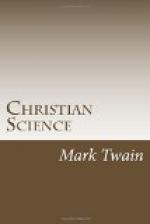That disappearance accounts for much in her miscellaneous writings. As I was saying, she handles her “ancestral shadows,” as she calls them, just as I do mine. It is remarkable. When she runs across “a relative of my Grandfather Baker, General Henry Knox, of Revolutionary fame,” she sets him down; when she finds another good one, “the late Sir John Macneill, in the line of my Grandfather Baker’s family,” she sets him down, and remembers that he “was prominent in British politics, and at one time held the position of ambassador to Persia”; when she discovers that her grandparents “were likewise connected with Captain John Lovewell, whose gallant leadership and death in the Indian troubles of 1722-25 caused that prolonged contest to be known historically as Lovewell’s War,” she sets the Captain down; when it turns out that a cousin of her grandmother “was John Macneill, the New Hampshire general, who fought at Lundy’s Lane and won distinction in 1814 at the battle of Chippewa,” she catalogues the General. (And tells where Chippewa was.) And then she skips all her platform people; never mentions one of them. It shows that she is just as human as any of us.
Yet, after all, there is something very touching in her pride in these worthy small-fry, and something large and fine in her modesty in not caring to remember that their kinship to her can confer no distinction upon her, whereas her mere mention of their names has conferred upon them a faceless earthly immortality.
CHAPTER II
When she wrote this little biography her great life-work had already been achieved, she was become renowned; to multitudes of reverent disciples she was a sacred personage, a familiar of God, and His inspired channel of communication with the human race. Also, to them these following things were facts, and not doubted:
She had written a Bible in middle age, and had published it; she had recast it, enlarged it, and published it again; she had not stopped there, but had enlarged it further, polished its phrasing, improved its form, and published it yet again. It was at last become a compact, grammatical, dignified, and workman-like body of literature. This was good training, persistent training; and in all arts it is training that brings the art to perfection. We are now confronted with one of the most teasing and baffling riddles of Mrs. Eddy’s history—a riddle which may be formulated thus:
How is it that a primitive literary gun which began as a hundred-yard flint-lock smooth-bore muzzle-loader, and in the course of forty years has acquired one notable improvement after another—percussion cap; fixed cartridge; rifled barrel; efficiency at half a mile how is it that such a gun, sufficiently good on an elephant hunt (Christian Science) from the beginning, and growing better and better all the time during forty years, has always collapsed back to its original flint-lock estate the moment the huntress trained it on any other creature than an elephant?




